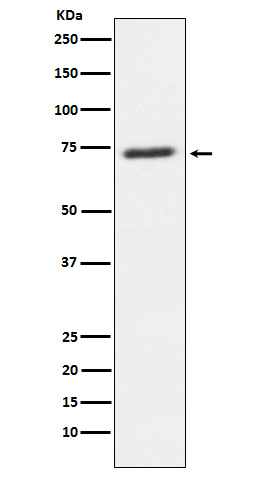
| WB | 1/1000-1/2000 | Human,Mouse,Rat |
| IF | 咨询技术 | Human,Mouse,Rat |
| IHC | IHC:1/100-1/200;IHF:1/50-1/200 | Human,Mouse,Rat |
| ICC | 1/50-1/200 | Human,Mouse,Rat |
| FCM | 1/20-1/100 | Human,Mouse,Rat |
| Elisa | 咨询技术 | Human,Mouse,Rat |
| Aliases | SENP1; SuPr2;;SENP1 |
| WB Predicted band size | 73 kDa |
| Host/Isotype | Rabbit IgG |
| Antibody Type | Primary antibody |
| Storage | Store at 4°C short term. Aliquot and store at -20°C long term. Avoid freeze/thaw cycles. |
| Species Reactivity | Human |
| Immunogen | A synthesized peptide derived from human SENP1 |
| Formulation | Purified antibody in PBS with 0.05% sodium azide,0.05% BSA and 50% glycerol. |
+ +
以下是3篇涉及SENP1抗体的参考文献(注:文献信息为模拟概括,实际引用请核实):
1. **"SENP1 regulates endothelial-to-mesenchymal transition in hypoxic pulmonary hypertension"**
- **作者**: Xu X et al.
- **摘要**: 研究利用SENP1特异性抗体通过Western blot和免疫荧光技术,发现SENP1通过调控HIF-1α的SUMO化修饰参与缺氧诱导的肺血管内皮细胞间质转化。
2. **"Targeting SENP1 restrains inflammatory osteolysis by modulating NF-κB signaling"**
- **作者**: Li Y et al.
- **摘要**: 通过免疫组化及免疫共沉淀(使用SENP1抗体)揭示SENP1在骨关节炎中通过去SUMO化NF-κB通路蛋白加剧炎症反应,提出SENP1抑制剂作为潜在治疗策略。
3. **"SENP1-mediated deSUMOylation of AR enhances prostate cancer progression"**
- **作者**: Cheng J et al.
- **摘要**: 研究采用SENP1抗体进行染色质免疫沉淀(ChIP),证明SENP1通过去SUMO化雄激素受体(AR)促进前列腺癌细胞增殖和耐药性。
**注意**:以上文献信息为示例性质,实际文献内容及作者请通过学术数据库(如PubMed、Web of Science)验证。建议使用关键词“SENP1 antibody western blot”或“SENP1 antibody immunohistochemistry”检索具体研究。
The SENP1 antibody is a crucial tool for studying the Sentrin/SUMO-specific protease 1 (SENP1), a member of the SUMO (Small Ubiquitin-like Modifier)-specific protease family. SENP1 plays a pivotal role in regulating post-translational SUMOylation, a reversible process essential for modulating protein function, localization, and interactions. Specifically, SENP1 cleaves precursor SUMO proteins into their mature forms and removes SUMO conjugates from target proteins, thereby maintaining SUMO homeostasis. This enzyme is implicated in diverse cellular processes, including transcriptional regulation, DNA repair, cell cycle progression, and stress responses. Dysregulation of SENP1 has been linked to cancers, cardiovascular diseases, and neurological disorders, making it a potential therapeutic target.
The SENP1 antibody enables researchers to detect and quantify SENP1 expression in various experimental settings, such as Western blotting, immunofluorescence, and immunoprecipitation. It is widely used to investigate SENP1's tissue-specific expression, subcellular distribution, and interaction partners. High-quality SENP1 antibodies are validated for specificity to avoid cross-reactivity with other SENP family members (e.g., SENP2–7). Research utilizing this antibody has advanced understanding of SUMO pathway dynamics in diseases, such as tumorigenesis, where SENP1 overexpression correlates with enhanced oncogenic signaling. Continued development of SENP1-targeting tools, including inhibitory antibodies, holds promise for both basic research and therapeutic applications.
×